2014 Peugeot 508 trailer
[x] Cancel search: trailerPage 5 of 352
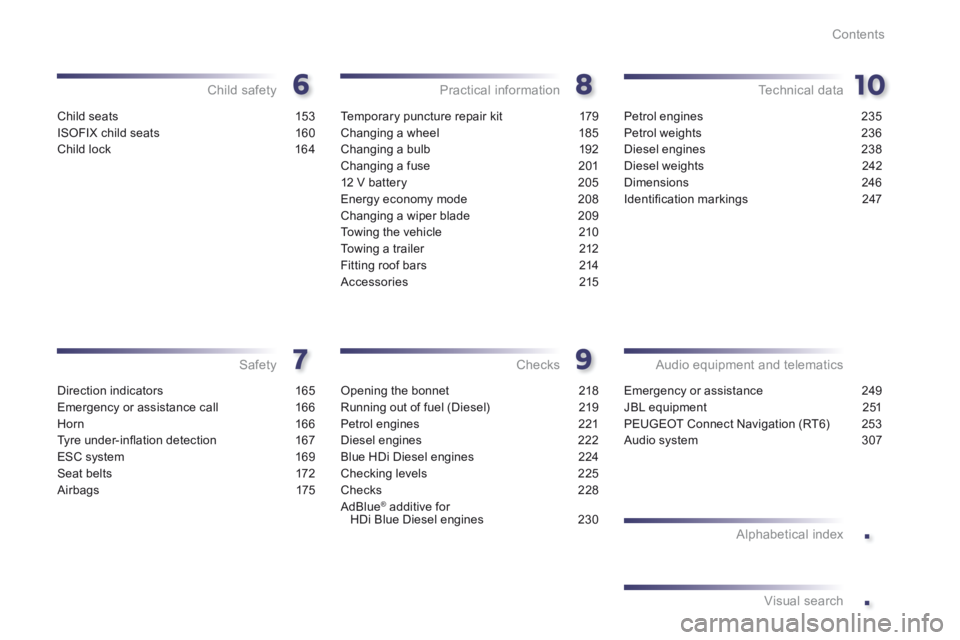
.
.
Contents
Child seats 153
ISOFIX child seats 160
Child lock 164
Child safety
Direction indicators 165
Emergency or assistance call 166
Horn 166
Tyre under-infl ation detection 167
ESC system 169
Seat belts 172
Airbags 175
Safety
Temporary puncture repair kit 179
Changing a wheel 185
Changing a bulb 192
Changing a fuse 201
12 V battery 205
Energy economy mode 208
Changing a wiper blade 209
Towing the vehicle 210
Towing a trailer 212
Fitting roof bars 214
Accessories 215
Practical information
Opening the bonnet 218
Running out of fuel (Diesel) 219
Petrol engines 221
Diesel engines 222
Blue HDi Diesel engines 224
Checking levels 225
Checks 228
AdBlue® additive for ® additive for ®
HDi Blue Diesel engines 230
Checks
Petrol engines 235
Petrol weights 236
Diesel engines 238
Diesel weights 242
Dimensions 246
Identifi cation markings 247
Technical data
Emergency or assistance 249
JBL equipment 251
PEUGEOT Connect Navigation (RT6) 253
Audio system 307
Audio equipment and telematics
Alphabetical indexVisual search
Page 23 of 352
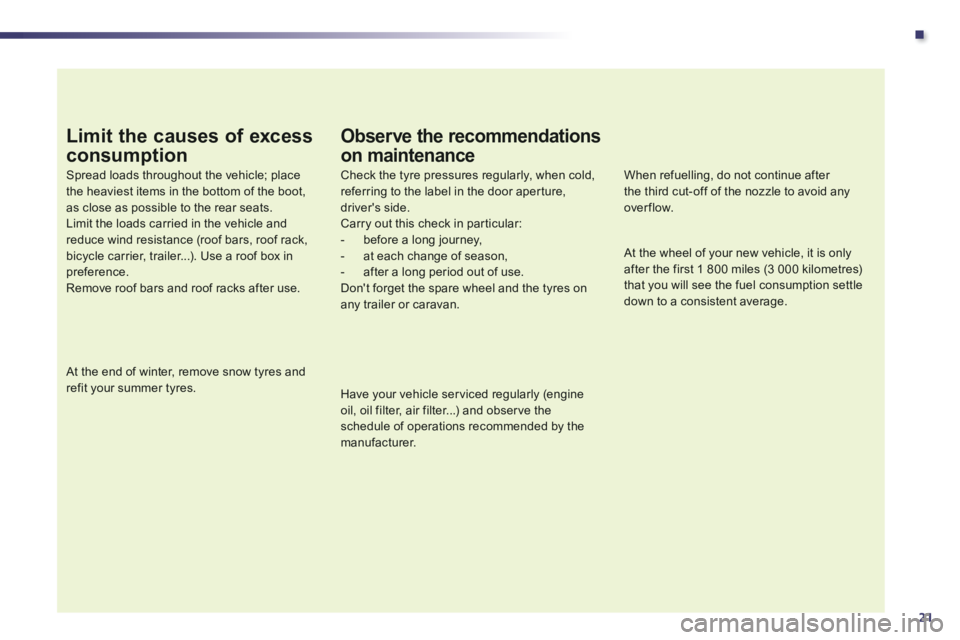
.
21
Limit the causes of excess
consumption
Spread loads throughout the vehicle; place the heaviest items in the bottom of the boot, as close as possible to the rear seats. Limit the loads carried in the vehicle and reduce wind resistance (roof bars, roof rack, bicycle carrier, trailer...). Use a roof box in preference. Remove roof bars and roof racks after use.
At the end of winter, remove snow tyres and refit your summer tyres.
Observe the recommendations
on maintenance
Check the tyre pressures regularly, when cold, referring to the label in the door aperture, driver's side.
Carry out this check in particular: - before a long journey, - at each change of season, - after a long period out of use. Don't forget the spare wheel and the tyres on any trailer or caravan.
Have your vehicle serviced regularly (engine oil, oil filter, air filter...) and observe the schedule of operations recommended by the manufacturer.
When refuelling, do not continue after the third cut-off of the nozzle to avoid any over flow.
At the wheel of your new vehicle, it is only after the first 1 800 miles (3 000 kilometres) that you will see the fuel consumption settle down to a consistent average.
Page 106 of 352

104
Driving
With the ignition on or the engine running, to release the parking brake, pressthe brake pedal , pull then release control lever A . The full release of the parking brake is confirmed by:
Manual release
- the braking warning lamp and the P warning lamp in the control lever A going off,
- display of the message "Parking brake off ".
If you pull the control lever A without pressing the brake pedal, the parking brake will not be released and a message appears in the instrument panel.
If necessary, you can make a maximum application of the parking brake. It is obtained by means of a long pull on control lever A , until you see the message "Parking brake applied fully" and an audible signal is heard. Maximum application is essential: - in the case of a vehicle towing a caravan or a trailer, if the automatic functions are activated but you are applying the parking brake manually, - when the slope you are parked on may vary (e.g. on a ferry, on a lorry, during towing).
Maximum application
Before leaving the vehicle, check that parking brake warning lamps in the instrument panel and in the control lever A are on fixed (not flashing). Never leave a child alone inside the vehicle with the ignition on, as they could release the parking brake.
Automatic application,
engine off
- illumination of the braking warning lamp and of the P warning lamp in the control lever A ,
- display of the message "Parking brake on".
With the vehicle stationary, the parking brake is automatically applied when the engine is switched off. The application of the parking brake is confirmed by:
In the case of towing, a loaded vehicle or parking on a gradient, make a maximum application of the parking brake then turn the front wheels towards the pavement and engage a gear when you park. After a maximum application, the release time will be longer.
Page 135 of 352
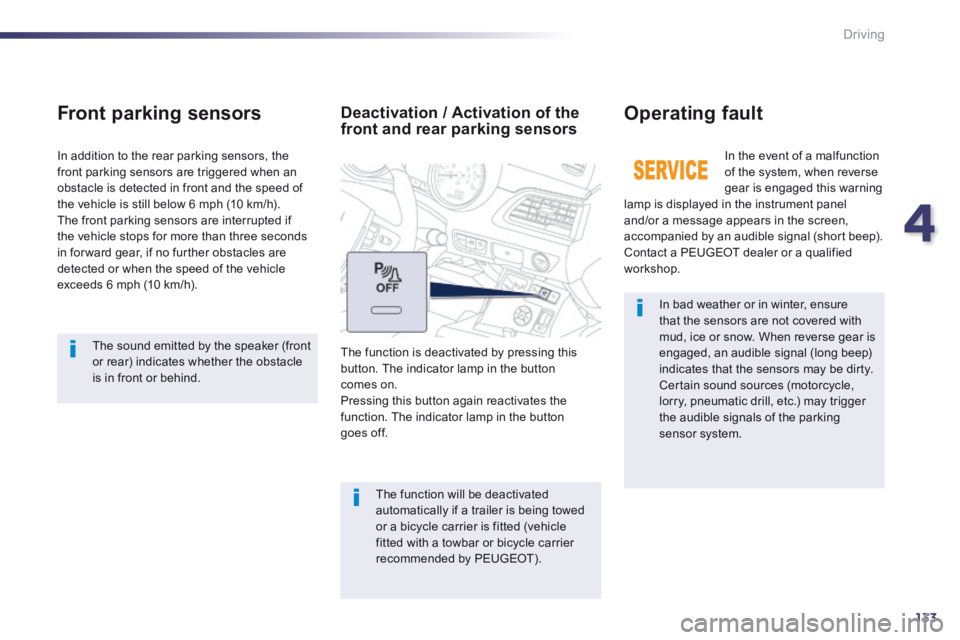
4
133
Driving
In bad weather or in winter, ensure that the sensors are not covered with mud, ice or snow. When reverse gear is engaged, an audible signal (long beep) indicates that the sensors may be dirty. Certain sound sources (motorcycle, lorry, pneumatic drill, etc.) may trigger the audible signals of the parking sensor system.
In the event of a malfunction of the system, when reverse gear is engaged this warning lamp is displayed in the instrument panel and/or a message appears in the screen, accompanied by an audible signal (short beep). Contact a PEUGEOT dealer or a qualified workshop.
Operating fault
In addition to the rear parking sensors, the front parking sensors are triggered when an obstacle is detected in front and the speed of the vehicle is still below 6 mph (10 km/h). The front parking sensors are interrupted if
the vehicle stops for more than three seconds in for ward gear, if no further obstacles are detected or when the speed of the vehicle exceeds 6 mph (10 km/h).
Front parking sensors
The function will be deactivated automatically if a trailer is being towed or a bicycle carrier is fitted (vehicle fitted with a towbar or bicycle carrier recommended by PEUGEOT).
Deactivation / Activation of the front and rear parking sensors
The function is deactivated by pressing this button. The indicator lamp in the button comes on. Pressing this button again reactivates the function. The indicator lamp in the button goes off.
The sound emitted by the speaker (front or rear) indicates whether the obstacle is in front or behind.
Page 205 of 352
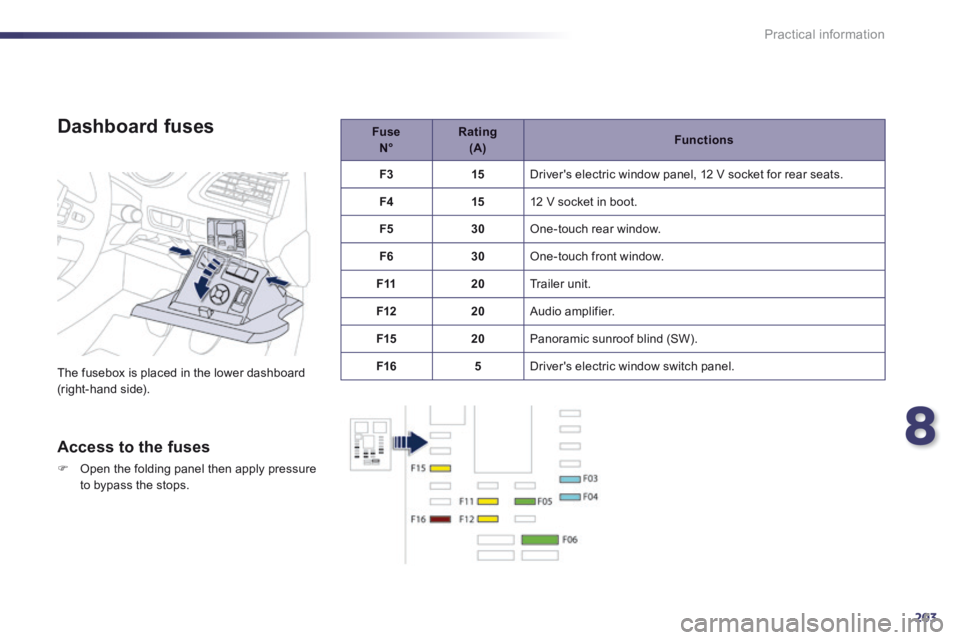
8
203
Practical information
Dashboard fuses
The fusebox is placed in the lower dashboard (right-hand side).
Access to the fuses
Open the folding panel then apply pressure to bypass the stops.
Fuse N° Rating (A) Functions
F3 15 Driver's electric window panel, 12 V socket for rear seats.
F4 15 12 V socket in boot.
F5 30 One-touch rear window.
F6 30 One-touch front window.
F11 20 Trailer unit.
F12 20 Audio amplifier.
F15 20 Panoramic sunroof blind (SW).
F16 5 Driver's electric window switch panel.
Page 214 of 352
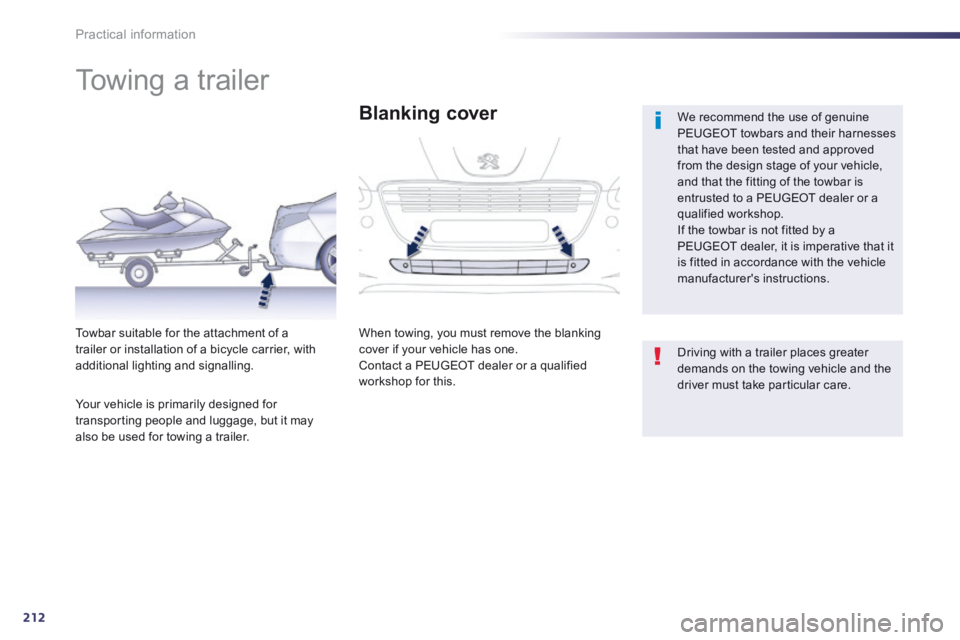
212
Practical information
Towing a trailer
We recommend the use of genuine PEUGEOT towbars and their harnesses that have been tested and approved from the design stage of your vehicle, and that the fitting of the towbar is entrusted to a PEUGEOT dealer or a qualified workshop. If the towbar is not fitted by a PEUGEOT dealer, it is imperative that it is fitted in accordance with the vehicle manufacturer's instructions.
Towbar suitable for the attachment of a trailer or installation of a bicycle carrier, with additional lighting and signalling.
Blanking cover
When towing, you must remove the blanking cover if your vehicle has one. Contact a PEUGEOT dealer or a qualified workshop for this.
Driving with a trailer places greater demands on the towing vehicle and the driver must take particular care.
Your vehicle is primarily designed for transporting people and luggage, but it may
also be used for towing a trailer.
Page 215 of 352
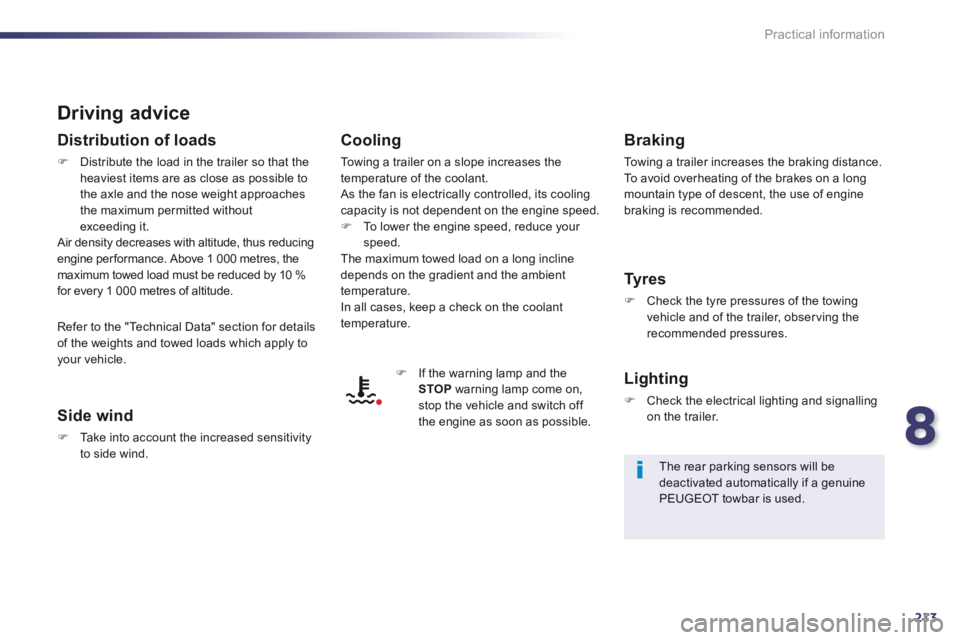
8
213
Practical information
Driving advice
Distribution of loads
Distribute the load in the trailer so that the heaviest items are as close as possible to the axle and the nose weight approaches the maximum permitted without
exceeding it. Air density decreases with altitude, thus reducing engine per formance. Above 1 000 metres, the maximum towed load must be reduced by 10 % for every 1 000 metres of altitude.
Side wind
Take into account the increased sensitivity to side wind.
Cooling
Towing a trailer on a slope increases the temperature of the coolant. As the fan is electrically controlled, its cooling capacity is not dependent on the engine speed.
To lower the engine speed, reduce your speed. The maximum towed load on a long incline depends on the gradient and the ambient temperature. In all cases, keep a check on the coolant temperature.
If the warning lamp and the STOP warning lamp come on, stop the vehicle and switch off the engine as soon as possible.
Braking
Towing a trailer increases the braking distance. To avoid overheating of the brakes on a long mountain type of descent, the use of engine braking is recommended.
Ty r e s
Check the tyre pressures of the towing vehicle and of the trailer, observing the recommended pressures.
Lighting
Check the electrical lighting and signalling on the trailer.
The rear parking sensors will be deactivated automatically if a genuine PEUGEOT towbar is used.
Refer to the "Technical Data" section for details of the weights and towed loads which apply to your vehicle.
Page 217 of 352
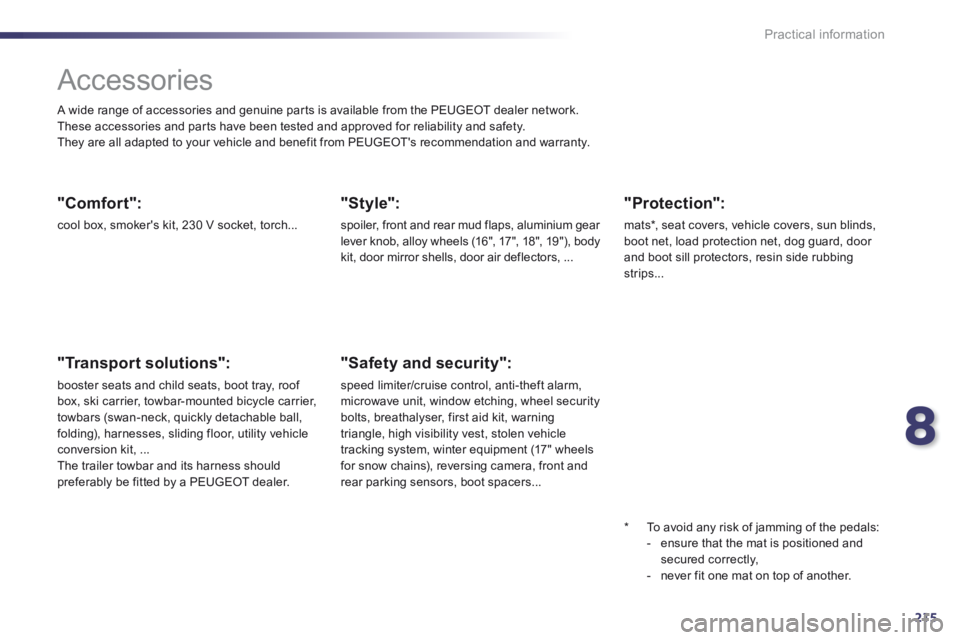
8
215
Practical information
Accessories
A wide range of accessories and genuine parts is available from the PEUGEOT dealer network. These accessories and parts have been tested and approved for reliability and safety. They are all adapted to your vehicle and benefit from PEUGEOT's recommendation and warranty.
"Comfort":
cool box, smoker's kit, 230 V socket, torch...
"Transport solutions":
booster seats and child seats, boot tray, roof box, ski carrier, towbar-mounted bicycle carrier, towbars (swan-neck, quickly detachable ball, folding), harnesses, sliding floor, utility vehicle conversion kit, ... The trailer towbar and its harness should preferably be fitted by a PEUGEOT dealer.
"Style":
spoiler, front and rear mud flaps, aluminium gear lever knob, alloy wheels (16", 17", 18", 19"), body kit, door mirror shells, door air deflectors, ...
* To avoid any risk of jamming of the pedals: - ensure that the mat is positioned and secured correctly, - never fit one mat on top of another.
"Safety and security":
speed limiter/cruise control, anti-theft alarm, microwave unit, window etching, wheel security bolts, breathalyser, first aid kit, warning triangle, high visibility vest, stolen vehicle tracking system, winter equipment (17" wheels for snow chains), reversing camera, front and rear parking sensors, boot spacers...
"Protection":
mats * , seat covers, vehicle covers, sun blinds, boot net, load protection net, dog guard, door and boot sill protectors, resin side rubbing strips...